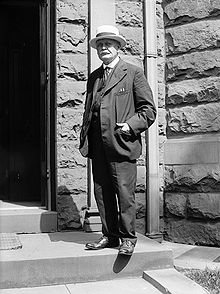Charles Edward Munroe
Charles Edward Munroe (born May 24, 1849 in Cambridge , Massachusetts , † December 7, 1938 in Forest Glen , Maryland ) was an American chemist who discovered the Munroe effect, which was named after him .
Life
Munroe studied at the Lawrence Scientific School at Harvard University and graduated in 1871. As an assistant professor of chemistry, he remained at the college until 1874 when he moved to Annapolis to become professor of chemistry at the United States Naval Academy . In 1886 he joined the Naval Torpedo Station at War College at Newport , Rhode Island , where he discovered the Munroe Effect. This is the basis for a shaped charge . From 1892 to 1917 Monroe was head of the Department of Chemistry and Dean of the Corcoran Scientific School at George Washington University . In 1894 he received his Ph. D. and in 1912 his LL. D of the university. In 1919 he retired as dean and became Dean Emeritus of the School of Graduate Studies and Professor Emeritus of Chemistry until his death.
Munroe wrote more than 100 books on chemistry and explosives . In 1900 he was nominated for the Nobel Prize in Chemistry . In addition, he was President of the American Chemical Society in 1898 and advisor to the United States Geological Survey and the United States Bureau of Mines . He was the last survivor of the founding members of the American Chemical Society in New York in 1876. In 1891 he was elected to the American Academy of Arts and Sciences .
Web links
- Charles Munroe Papers Online Collection , Special Collections Research Center, Estelle and Melvin Gelman Library, The George Washington University.
- Charles Munroe Papers, 1894–1936 (1 linear ft.) Are housed in the Special Collections Research Center, Estelle and Melvin Gelman Library, The George Washington University
Individual evidence
- ↑ Biography of Charles Edward Munroe (1849-1938). Accessed July 31, 2016 .
- ^ Charles E. Browne (1939) "Charles Edward Munroe 1849-1938," Journal of the American Chemical Society , vol. 61, no. 5, pages 1301-1316.
- ↑ Donald R. Kennedy, History of the Shaped Charge Effect: The First 100 Years (Los Alamos, New Mexico: Los Alamos National Laboratory, 1990), pages 55-56.
| personal data | |
|---|---|
| SURNAME | Munroe, Charles Edward |
| BRIEF DESCRIPTION | American chemist and university professor |
| DATE OF BIRTH | May 24, 1849 |
| PLACE OF BIRTH | Cambridge , Massachusetts , United States |
| DATE OF DEATH | December 7, 1938 |
| Place of death | Forest Glen , Maryland , United States |
